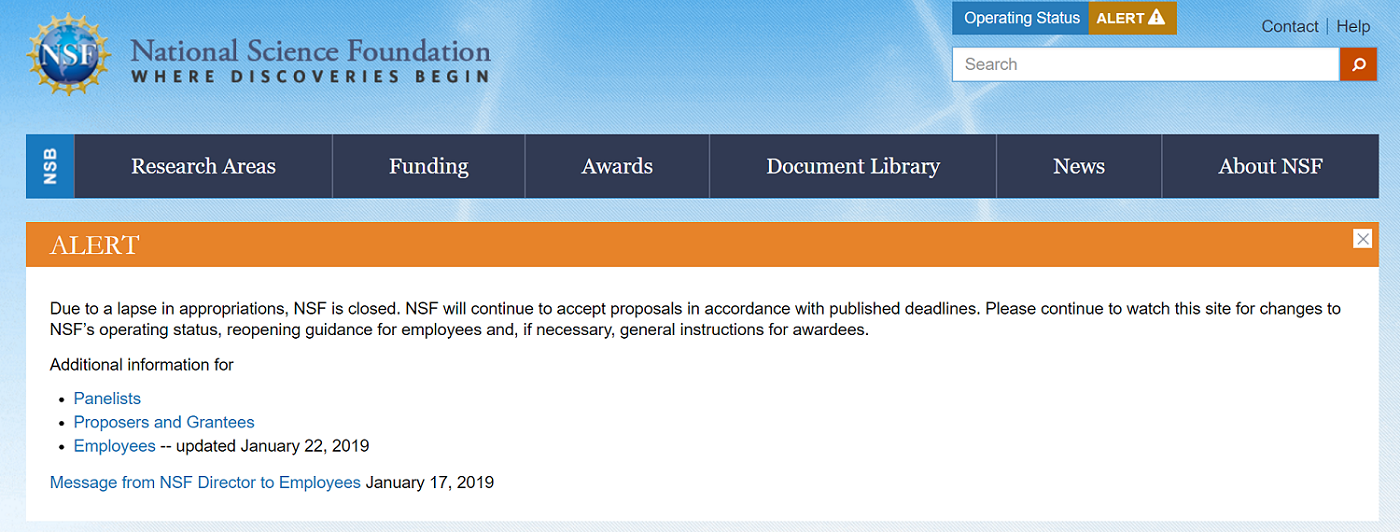After a 35-day federal government shutdown, the longest in U.S. history, government agencies are taking stock of the damage — and girding for a potential second shutdown. While the Department of Energy had already secured its budget before the shutdown went into effect, other science agencies, including the National Science Foundation and Commerce (NIST & NOAA), were not spared. NSF was closed during the funding lapse and the Data.gov website was offline.
According to the American Society for Biochemistry and Molecular Biology, which tracked the impact to NSF research grants, there were 465 grants awarded at NSF from December 22, 2017, through January 25, 2018, valued at $139.2 million, while a year later, the were 0 research grants awarded, valued at $0.00, during the equivalent time frame. The Science Coalition estimates that $1.3 billion in fundamental scientific research was put on hold because of the government shutdown.
The positive news for high-performance computing is that most HPC-relevant activities were sufficiently funded to get through the period. At NSF, quantum computing and AI efforts, which broadly fall under NSF’s Big Ideas umbrella, are also said to be on track.
In a phone call held to brief reporters last Friday, key NSF staff discussed impacts to the agency, which is aggressively working to resume full activities, while facing the prospect of another closure when short-term federal funding expires on February 15.
One of the most significant impacts of the shutdown on NSF was the cancellation of more than 100 panels to review and fund research proposals. The agency currently is in the process of resuming panels and rescheduling missed panels to get back on track, according to Deputy Assistant Director Computer & Information Science & Engineering Erwin P. Gianchandani. The agency is also resuming the processing of new programs and solicitations that were in clearance at the time of the appropriations lapse, said Gianchandani.

While the impact to specific programs is still being assessed, NSF’s 10 Big Ideas initiative continues to be a priority. “With respect to AI and quantum computing, we’ve had several conversations internally this week and we feel pretty confident about our ability to be able to execute on our original plans, vis a vis those priorities for AI and quantum for the rest of this fiscal year,” Gianchandani told HPCwire.

Gianchandani also shared that the NSF Frontera supercomputer being installed at the Texas Advanced Supercomputer and other existing HPC resources were not paused during the shutdown, apart from the ability of awardees to draw down funds through ACM [NSF’s award cash management system]. “We do believe and we have heard that the HPC resource at Texas as well as the other resources that are available to the community are continuing to be on track at this point,” he said.
Reached for comment, Senior Fellow at the U.S. Council on Competitiveness Alex Larzelere said that critically for the HPC community the Department of Energy remained open during the shutdown. The DOE budget was secured as part of the Energy and Waters appropriation that was signed by the president at the end of September. It was the first time in over a decade that DOE started the year with a full fiscal year of funding, Larzelere told us.
“This means that the Exascale Computing Project and the exascale procurements are on track,” said Larzelere. “In fact, if they are keeping to their schedule, we should be hearing about the CORAL2 results any day now. So, for DOE, the partial shutdown is moot. The same can be said for the DoD HPC Modernization program. And it also applies to the DOE quantum and AI efforts.”
If lawmakers do not resolve the budget impasse by February 15, the U.S. is facing a second partial government shutdown. NSF staff noted that they are taking steps to prepare as best they can.
“From an HR perspective, now that our priorities for reopening the agency have mainly concluded, we are meeting on a daily basis to start prepping for the possibility of another shutdown,” stated Acting Chief Human Capital Officer Javier E. Inclán. “However there are certain things that need to be normal operations and then there are other things that based on the length of this recent shutdown we have a better idea of how to prepare for any lapse of appropriations going forward.”
“With respect to our major facilities, because the new continuing resolution gives us a pretty big amount of funding from the Dec. 21 to Feb. 15 period, we’ll be working to obligate funds out to our facilities so they can continue to operate even in the unfortunate event of another lapse,” said James S. Ulvestad, chief officer for research facilities.
“From a programmatic standpoint in terms of proposal review and processing, we always try to take steps to be prepared for a potential lapse, and so we do have plans that we are proceeding on with respect to what happens in the event of a lapse and with respect to panels that are scheduled for later this month,” added Gianchandani.



























































